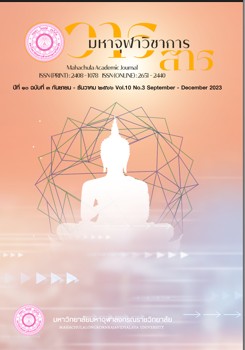Characteristics and values of Lanna Nan dhamma hall
Main Article Content
Abstract
The objectives of this article were 1) to study the history of the Lanna Nan Dhamma Hall, 2) to study the characteristics and values of the Lanna Nan Dhamma Hall and 3) to present a guideline for conservation of the Lanna Nan Dharma Hall. This research was qualitative research, analyzing data by content descriptive method. This research was found that: Dhamma Hall was a term for the Tipitaka Hall of Lanna Thai people as a symbol of the existence of Buddhism. It was a place where palm-leaf manuscripts were stored that engraved the teachings of the Lord Buddha. Na Tao Temple’s Dhamma Hall was a remarkable construction that blended Lanna, Lao, and Chinese artistic styles. It featured a square-shaped building, although its construction remains unidentified. Na Pang Temple’s Dhamma Hall was constructed in 1857 during the reign of Chao Ananta Worarithidej. it preserved the Lanna script, and the letters in the Na Pang script were considered the most exquisite in the northern region. And the last, Hua Khuang Temple’s Dhamma Hall was constructed in 1883 under the patronage of Chao Ananta Worarithidej as a Buddhist altar.The Lanna Nan Dhamma Hall had 6 general characteristics: 1) Lanna Kanok pattern 2) plant ornaments pattern 3) Flower patterns 4) Phum Khao Bin pattern 5) Thep Nom pattern and 6) The Naga pattern. Characteristics of the Lanna Nan Dharma Hall located in Na Tao temple was distinguished by its one-story architecture constructed with bricks and cement. It followed a square layout design. Similarly, it found in the Na Pang temple exhibited one-story architecture, but with a high basement. It also followed a square layout design. In contrast, the Lanna Nan Dharma Hall located within the Hua Khuang temple showcased a two-story architecture with a square layout. The lower level was constructed with bricks, while the upper level was made of wood. Conserving the Lanna Nan Dhamma Hall had 3 main issues: 1) Exploring the problems of the Dhamma Hall in 3 aspects, namely the cause of deterioration, impact, and deterioration characteristics. 2) Guidelines for conservation of the Lanna Nan Dharma Hall in 4 aspects, namely creating knowledge and understanding of the preservation of ancient sites in the temple area for monks and temple administrators, giving knowledge and understanding of fine arts and concepts of restoration to monks and staff of the Fine Arts Department, giving knowledge and understanding of fine arts and concepts of rehabilitation to monks and staff of the Fine Arts Department, and the roles and responsibilities of the National Office of Buddhism and the Sangha Act on the preservation and maintenance of Buddhist places in relation to the maintenance of ancient sites within the temple. And 3) The 4 steps of Lanna Nan Dhamma Hall conservation process, namely preliminary data collection, basic preservation, advanced preservation and development of ancient sites.
Article Details

This work is licensed under a Creative Commons Attribution-NonCommercial-NoDerivatives 4.0 International License.
References
กรมส่งเสริมวัฒนธรรม กระทรวงวัฒนธรรม. วัฒนธรรมวิถีชีวิตและภูมิปัญญา. กรุงเทพมหานคร: สำนักนายกรัฐมนตรี, ๒๕๕๘.
กรมส่งเสริมวัฒนธรรม กระทรวงวัฒนธรรม. วัฒนธรรมวิถีชีวิตและภูมิปัญญา. กรุงเทพมหานคร: บริษัทรุ่งศิลป์การพิมพ์ (๑๙๗๗) จำกัด, ๒๕๕๙.
ก่องแก้ว วีระประจักษ์. สารานุกรมไทยสำหรับเยาวชนฯ เล่มที่ ๓๐ เรื่องที่ ๒. [ออนไลน์]. แหล่งที่มา: https://www.saranukromthai.or.th/sub/book/book.php?book=๓๐&chap=๕&page=t๓๐-๕-infodetail๐๑.html. [๑๘ กรกฎาคม ๒๕๖๔].
จักรพงษ์ คำบุญเรือง, สถาปัตยกรรมล้านนาที่หอไตรวัดบ้านหลุก, [ออนไลน์], แหล่งที่มา: https://www.chiangmainews.co.th/page/ archives/๑๑๖๐๗๘๖/. [๑๘ มกราคม ๒๕๖๔].
พระใบฏีกาปิยะ จิรธมฺโม. เอกสารประวัติวัดนาเตา. (ม.ป.ท.: ม.ป.พ., ๒๕๕๙), (เอกสารอัดสำเนา).
ภาณุรังษี เดือนโฮ้ง และ วาณี อรรจน์สาธิต.“นครน่านเมืองเก่าที่มีชีวิต : อัตลักษณ์ทางประวัติศาสตร์และวัฒนธรรม”. วารสารวิชาการและวิจัยสังคมศาสตร์. ปีที่ ๑๐ ฉบับพิเศษ (กรกฎาคม ๒๕๕๘). ๑๒๓.
มหาวิทยาลัยมหาจุฬาลงกรณราชวิทยาลัย. พระไตรปิฎกภาษาไทย ฉบับมหาจุฬาลงกรณราชวิทยาลัย. กรุงเทพมหานคร: โรงพิมพ์มหาจุฬาลงกรณราชวิทยาลัย, ๒๕๓๙.
มารุต อมรานนท์. “การศึกษาจิตรกรรมฝาผนังในจังหวัดชลบุรี”. รายงานการวิจัย. มูลนิธิ เจมส์ เอช ดับเบิ้ลยู ทอมย์สัน, ๒๕๓๐-๒๕๓๑.
ศิริศักดิ์ อภิศักดิ์มนตรี และคณะ. “ไม่เห็นคุณค่าก็กลายเป็นถังขยะ : บทวิเคราะห์คุณค่าหอไตรล้านนา”. วารสารดำรงวิชาการ. ปีที่ ๑๔ ฉบับที่ ๒ (กรกฎาคม-ธันวาคม ๒๕๕๘). ๑๑-๔๒.
สันติ เล็กสุขุม. ลวดลายปูนปั้นแบบอยุธยาตอนปลาย (พ.ศ. ๒๑๗๒–๒๓๑๐). กรุงเทพมหานคร:มูลนิธิ เจมส์ทอมป์สัน, ๒๕๓๒.


